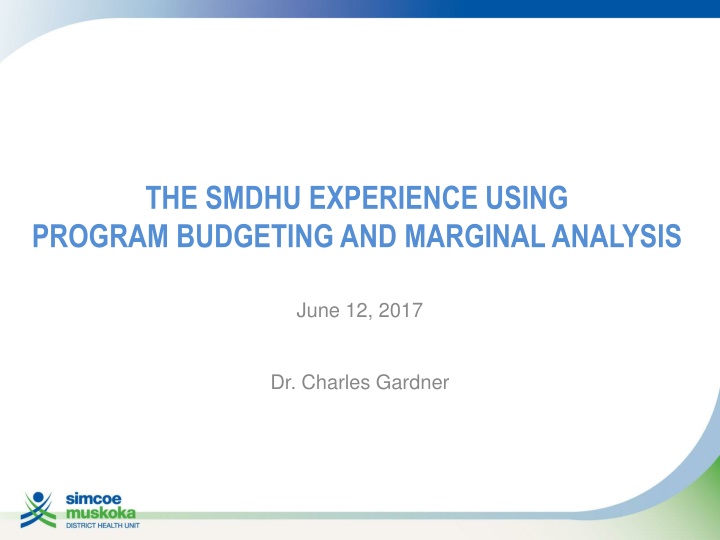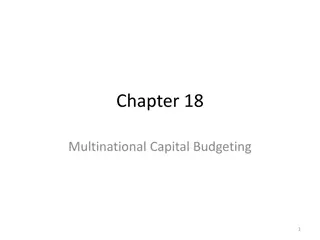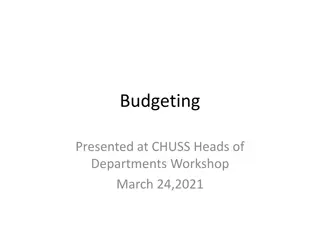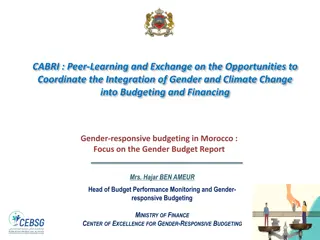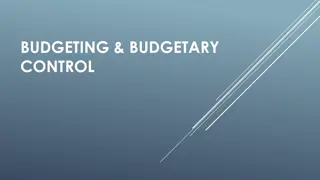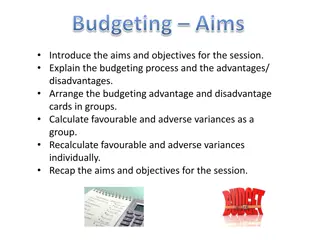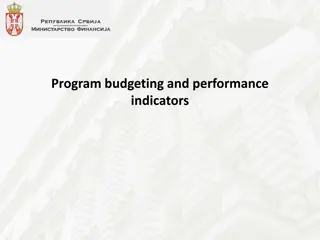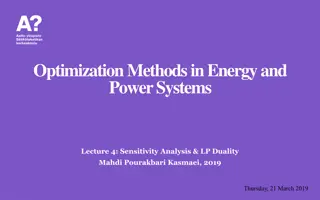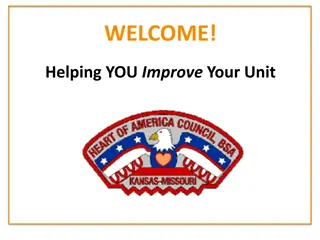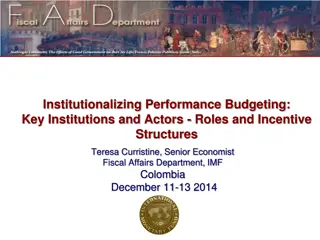The SMDHU Experience with Program Budgeting and Marginal Analysis
The SMDHU faced challenges due to a grant freeze in 2015, resulting in staff reductions, departmental changes, and operational savings. This led to the adoption of Program Budgeting and Marginal Analysis (PBMA) as a resource management tool. PBMA was chosen after groundwork and evaluation, aiming to generate proposals for budget disinvestment while aligning resources with strategic priorities and maintaining public health mandates. The approach involves providing recommendations to the Board for informed funding decisions, despite a shortened timeline.
Download Presentation

Please find below an Image/Link to download the presentation.
The content on the website is provided AS IS for your information and personal use only. It may not be sold, licensed, or shared on other websites without obtaining consent from the author.If you encounter any issues during the download, it is possible that the publisher has removed the file from their server.
You are allowed to download the files provided on this website for personal or commercial use, subject to the condition that they are used lawfully. All files are the property of their respective owners.
The content on the website is provided AS IS for your information and personal use only. It may not be sold, licensed, or shared on other websites without obtaining consent from the author.
E N D
Presentation Transcript
THE SMDHU EXPERIENCE USING PROGRAM BUDGETING AND MARGINAL ANALYSIS June 12, 2017 Dr. Charles Gardner
FACULTY/PRESENTER DISCLOSURE Faculty: Dr. Charles Gardner Relationships with commercial interests: Not Applicable Potential for conflict(s) of interest: No Commercial Support
CONTEXT: THE NEED TO RATIONALIZE IN 2016 The 2015 grant freeze impacts in SMDHU: The loss of over 11 FTEs in staffing positions, including three management positions The reorganization of the agency with a reduction of one department The closure of a sexual health clinic Slimmed agency strategic plan $90,000 in operational savings achieved Anticipating multi-year grant freezes
WHY PBMA? Groundwork by 3 successive PHPM residents (over 18 months) Review of academic paper on PBMA in fall of 2015 Literature and field experience review in spring of 2016 interviews with 4 HUs Operational model in fall of 2016 SMDHU experience evaluation winter 2017 Opportunity for disinvestments Did not pursue Investments for 2017 Improved resource alignment with strategic priorities Used at various Regional Health Authorities and Public Health Units across Canada LGL, MLHU, KFL&A, Ottawa Fosters multi-level engagement sense of ownership of decisions Board and senior management Managers developed proposals (information from their staff)
APPROACH AND INTENTIONS Tool for effective resource management To generate proposals for disinvestment of up to 3% of the annual budget in 2017 Based on assumed 2% loss with provincial grant freeze Allowing additional 1% for differential PBMA impacts between departments Provide recommendations for disinvestment, thereby informing annual budget, operational and work plans Identify best options for resource reductions while continuing to meet our public health mandate Provide the Board with tangible information on the impacts of different funding decision options re the 2017 budget Shortened timeline to accommodate this Will be part of ongoing and annual planning cycle
DEVELOPING A LEADERSHIP MODEL Summer of 2016 Senior management developed the model Board of Health approval Project Manager, and Assistant PM recruited (from among management, and PHPM resident respectively) Job descriptions developed Supervised by MOH Agency staff communication strategy and HR functions Need, intentions, approach, timelines, outcome Development of layoff / bumping protocols (union and non-union) Continuation of the communications from the 2015 downsizing response
INTEGRATED PLANNING PROCESS Site Visit Proposals Outputs Staff informed re: PBMA Communications plan Criteria review Exec Committee assesses, ranks, and reviews proposals Proposal implementations assessed Criteria development Presentation to managers and staff Managers draft proposals for disinvestment Directors vet proposals for presentation to Exec Committee 2017 Budget Strategic Plan 2017 Op Plan Initial Exec and Board Review Board Review Communication October 2016 March 2017 PBMA Implementation Timeline
REVIEW SCOPE Disinvestments only in 2017 Included Excluded - All departments (incl. MOH office) All program components involving cost-shared funds Staffing related costs (salary, benefits) for all staff Operating costs - Program components that are 100% provincially funded - - -
2017 SMDHU CRITERIA Criteria Health Impact Legislative Requirement Urgent Public Health Issues Efficiency Organizational Capacity Client Experience Determinants of Health Workplace Environment Collaboration/Partnerships Innovation/Knowledge Management Implementation Challenges Weighting 16 16 12 10 10 7.5 9 5 7.5 4 4
RISK ASSESSMENT alPHa Risk Management Tool Used in the marginal analysis, in addition to the criteria scores Also considered (but did not select) the following: MOHLTC BOH Risk Tool piloted at SMDHU in 2013 MCSS/MCYS Agency Risk Assessment Reporting Tool
PROPOSAL REVIEW - GROUND RULES 2 full day meetings of senior management ( Executive Committee ) reviewed / scored the proposals: implementation plan, financial tab, impact and risks Consensus rule can anyone not live with this change/rating? Proposal discussion focused on criteria Limited time needed to be efficient Made use of the parking lot for questions Parking lot items and proposals with questions was re-addressed in subsequent meeting First few rated proposals were reviewed and revised at the end to ensure consistency
OVERALL RESULTS Total Value of submissions $650,000 Range $5,200 to $56,000 37 proposals submitted for review From all departments, including MOH office Ratings ranged from +71 to -135.5 (out of possible range from +300 to -300) Majority had FTE implications Selection cutoff of proposals at $450,000 Implementation challenges concentrated in the proposals scoring out of the cutoff Health promotion programming was not disproportionately impacted Percent of total disinvestments varied by department, beyond proportion of agency budget Department 1: 26% of cost-shared budget but only 12% of all disinvestments selected Department 2: 20% of cost shared budget, 26% of all disinvestments selected
DECISIONS Board chose to increase levy by 2% and draw on surplus No longer 25 / 75 municipal / provincial funding balance: 27 / 73 in 2016 4 Proposals to action identified through PBMA process Net efficiency gains Rated scores: -16 to +71
POST IMPLEMENTATION EVALUATION FINDINGS Communications key - geared to specific audiences including Board of Health, Directors, Managers and staff Need for strong project management Many HR considerations / preparations to be managed Be prepared for possible amendments to timelines and the need for flexibility
FUTURE DIRECTIONS UPCOMING YEAR Assume ongoing provincial grant freeze Need to consider the application of the new public health standards / Patients First within the PBMA process Investment proposals Include 100% provincially funded programs
FINAL THOUGHTS PBMA is a method for making rationale decisions re scarce resources Method employed by SMDHU with success, going into our 2nd year
